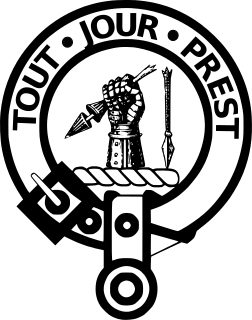
Dunfermline Abbey is a Church of Scotland Parish Church in Dunfermline, Fife, Scotland. The church occupies the site of the ancient chancel and transepts of a large medieval Benedictine abbey, which was sacked in 1560 during the Scottish Reformation and permitted to fall into disrepair. Part of the old abbey church continued in use at that time and some parts of the abbey infrastructure still remain. Dunfermline Abbey is one of Scotland's most important cultural sites.

Fife is a council area, historic county, registration county and lieutenancy area of Scotland. It is situated between the Firth of Tay and the Firth of Forth, with inland boundaries with Perth and Kinross and Clackmannanshire. By custom it is widely held to have been one of the major Pictish kingdoms, known as Fib, and is still commonly known as the Kingdom of Fife within Scotland. A person from Fife is known as a Fifer. In older documents the county was very occasionally known by the anglicisation Fifeshire.

James Stewart, 1st Earl of Moray, a member of the House of Stewart as the illegitimate son of King James V, was the regent of Scotland for his half-nephew, the infant King James VI, from 1567 until his assassination in 1570. He was the first head of government to be assassinated by a firearm.

Burntisland is a former royal burgh and parish in Fife, Scotland, on the northern shore of the Firth of Forth. According to the 2011 census, the town has a population of 6,269. It was previously known as Wester Kinghorn or Little Kinghorn.

Clan MacDuff or Clan Duff is a Lowland Scottish clan. The clan does not currently have a chief and is therefore considered an Armigerous clan, which is registered with the Lyon Court. The early chiefs of Clan MacDuff were the original Earls of Fife, although this title went to the Stewarts of Albany in the late fourteenth century. The title returned to the MacDuff chief when William Duff was made Earl Fife in 1759. His descendant Alexander Duff was made Duke of Fife in 1889.

Rossend Castle is a historic building in Burntisland, a town on the south coast of Fife, Scotland.
Ethelred was the son of King Malcolm III of Scotland and his wife Margaret of Wessex, the third oldest of the latter and the probable sixth oldest of the former. He took his name, almost certainly, from Margaret's great-grandfather Æthelred the Unready. He became the lay abbot of Dunkeld.

Clan Leslie is a Lowland Scottish clan. The progenitor of the Clan, Bartolf, was a nobleman from Hungary, who came to Scotland in 1067. He built a castle at Lesselyn, from which the clan name derives.

Clan Carmichael is a Scottish clan and is also considered a sept of the Clan Douglas, Clan MacDougall, Stewart of Appin, and Stewart of Galloway.

Clan Cathcart is a Lowland Scottish clan.

Clan Seton is a Scottish clan which does not currently have a chief; therefore, it is considered an armigerous clan.

Clan Colville is a Lowland Scottish clan.

Clan Maitland is a Lowland Scottish clan.

Clan Wemyss is a Lowland Scottish clan.

George Durie, abbot of Dunfermline and archdeacon of St Andrews, son of John Durie of Durie in the county of Fife, and brother to Andrew Durie, bishop of Galloway, was born about 1496. From 1527 till 1530 he acted as judge and executor of the monastery of Arbroath. During this same period he assumed the title of abbot of Dunfermline, and discharged some of the duties of that office under the direction of his uncle, Archbishop James Beaton, the actual titular, on whose death in 1539 he was promoted by James V to the full dignity of the office.

Collessie is a village and parish of Fife, Scotland. The name derives from Scottish Gaelic but is somewhat obscure in its current form. The first element is either cùl (behind) or cùil (nook) and the last element could be either eas (waterfall) or lios.

Robert Pitcairn (1520?–1584) was a Scottish administrator, diplomat and judge, secretary of state and commendator of Dunfermline.
Robert Melville, 1st Lord Melville was a Scottish diplomat, administrator, jurist, and intriguer, and uncle of the poet Elizabeth Melville.
Henry Kemp of Thomastoun was a Scottish courtier.


















